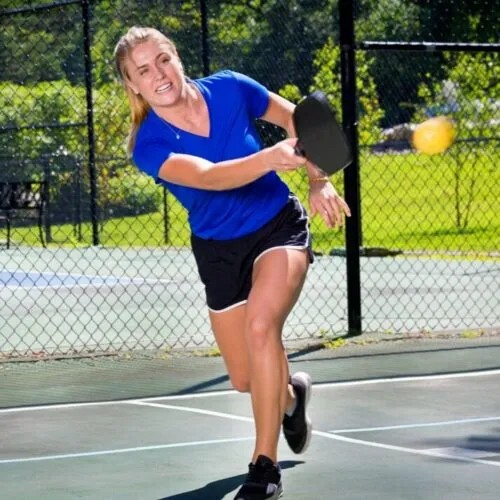It’s really no surprise that pickleball is one of the fasting growing sports in our community. It’s fun, good exercise, a stress reliever, low impact, and a great social outlet.
Statistics show that the majority of people that participate in pickleball are middle-aged and the sport is rapidly growing in popularity among those ages 50-60. If this is you, it may have been awhile since you were involved in competitive sports. And for many, although pickleball is fun, they do take their performance and ability on the court quit seriously.
What we need to take just as seriously is our ability to keep enjoying the game for years to come. That means preventing injuries and keeping our body strong and fit.
There are acute injuries that occur during pickleball – a pulled hamstring, ruptured tendon, a fall, or broken bone. Accidents can happen in any activity where we move in different directions and have to quickly react. However, the incidence of these types of injuries is relatively low in the sport.
More often, injures occur due to the repetitive nature of pickleball. This causes more chronic injuries – the nagging aches and pains that seem to get better with rest but never really go away. The kind that we put up with until we just can’t anymore and end up calling it quits.
In order to perform our best and continue to play well season after season, resolution and prevention of these chronic injuries is crucial. Let’s cover the most common of these injuries and how we can prevent them.
Most Common Pickleball Injuries and How to Treat Them
1. Tennis Elbow or Wrist Pain
Just like in tennis, swinging a racquet can cause strain in the tendons that flex and extend the wrist or elbow. Discomfort develops over time associated with repetitively hitting the ball. If the problem is newly developed, working on proper ball striking form can fix the problem.
However, if the problem has become chronic there is likely inflammation and possibly even scar tissue formation that needs to be worked on by a manual physical therapist. We find Astym treatments to be most effective.
2. Plantar Fasciitis
Plantar fasciitis typically results from irritation of the tissue that runs from the heel across the arch of the foot. This can be treated with stretching, arch strengthening exercises, and possibly shoe orthotics.
Again, if the problem has been going on for a long time, Astym therapy to regenerate the damaged tissue may be beneficial, especially if other treatments have not solved the problem.
3. Shoulder Impingement
Often referred to as “tendinitis” or “bursitis” of the shoulder, this is when the rotator cuff tendons get irritated. This is far less common in pickleball than other sports because there is less overhead movements which is what tends to cause this problem.
Proper stretching and warm ups should limit shoulder problems. If you do not have full range of movement in your shoulder, this needs to be addressed with a physical therapist first.
4. Ankle or Knee Sprain
A sprain of the knee or ankle can occur due to quick pivoting movements and rapid starting/stopping. A sprain is usually felt immediately and can make the leg affected painful to put weight on.
Recovery is dependent on the severity of the sprain, but in most cases gentle movement without exceeding pain tolerance is important to stimulate tissue healing.
5. Hamstring Strain
“Pulling a hamstring” is a complaint we hear often. It usually occurs when we get aggressive and lunge for a ball a bit out of our reach.
Muscles that are well hydrated and flexible are less likely to sustain this type of injury. In addition, working on improving strength through the hip and buttocks can help “rehab” a hamstring by providing it proper support.
6. Back Strain
Back aches and pains are usually made worse with forward bending and repetitive rotation of the body. Conditioning of the muscles in the back, core, and legs can help prevent injury.
If back pain is an ongoing issue, then manual therapy to address alignment and proper range of movement through the spine may be necessary.
Just like any sport, improving flexibility, mobility, and endurance will result in improved performance and injury prevention. In fact, when it comes to pickleball, you can often pull out a win by outlasting your opponent. Mistakes and injuries most often happen when a player is fatigued.
Remember, although traumatic injuries are not as likely in pickleball, chronic overuse type injuries are. Think of terms such as sprain and strain as opposed to break or tear. This is good news, because many of these ailments are easily treated or can be prevented in the first place.
The injuries listed above respond well to physical therapy and this can help players return to the game, play without discomfort, and even compete at a higher level. Worried that an ache, pain, weakness, or poor endurance is limiting your performance?
Click the link below to talk with an expert today. Our doctors of physical therapy can get you back on the court and feeling your best.


